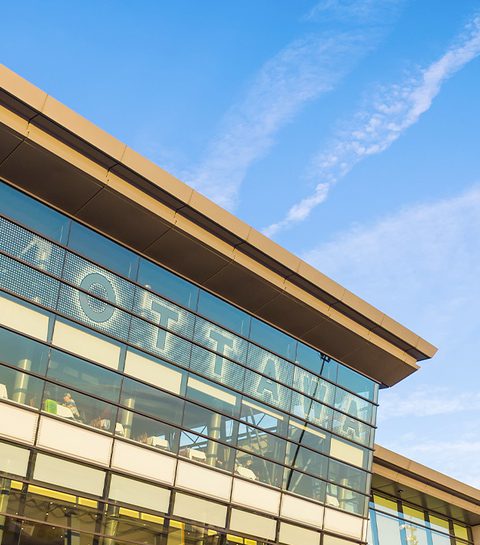2021 Environmental Performance


The Ottawa Airport Authority (the Authority) is committed to improving environmental performance and tracks its progress through the following key performance indicators:
STORMWATER QUALITY
De-icing
For safety reasons, aircraft require de-icing during the winter months. The Authority monitors all stormwater property outlets for glycol and other parameters resulting from de-icing activities. Early in the 2020-2021 season (early December 2020), glycol readings exceeded the acceptable limit at one property outlet during a malfunction at the Central De-icing Facility. This exceedance was reported to the Ontario Spill Action Centre. The glycol recovery procedures were re-evaluated and modified. After the recovery procedure modifications, no exceedances were observed.
2022 Goals
- Continue to monitor the outlets to identify and mitigate issues.
- Continue to monitor operations and modify as necessary to minimize the potential for glycol impact.
- Not to exceed the glycol guidelines.
Type I and Type IV Glycol application (in litres)
2021-2022 winter season: 1,626,458*
2020-2021 winter season: 516,170*
2019-2020 winter season: 3,019,859
2018-2019 winter season: 3,535,468
2017-2018 winter season: 3,551,589
*Significant decrease in air traffic due to the pandemic significantly reduced the amount of glycol used at YOW.
Ground handling
Accidental spills typically occur due to human error or equipment malfunction, mainly during aircraft servicing. The Authority and operators work to minimize the impact when spills occur. Most spills occur on hard surfaces, and the responsible parties clean them immediately. In 2021, 48 spills were reported, and all spills were contained and prevented from entering the environment.
2022 Goals
- Continue to promote employee awareness.
- Continue to promote regular equipment maintenance to reduce the number of spills.
- Ensure no significant environmental impact from spills.
Significant spills
(Large enough to require being reported to Environment and Climate Change Canada and the Ontario Ministry of the Environment, Conservation and Parks)
2021: 0
2020: 0
2019: 0
2018: 0
2017: 0
2016: 1
AIR QUALITY
In 2016, the Authority received Airports Council International (ACI) Carbon Accreditation Program Level 1 - Mapping certification. In 2017, the Authority achieved Level 2 - Reduction certification, which required developing and implementing a comprehensive Greenhouse Gases (GHG) Management Plan. In 2018, we retained our Level 2 certification and applied for Level 3 certification, which required third-party airport partners’ engagement, such as airlines, ground handlers and landside tenants. We obtained Level 3 certification in 2018 and certified Level 3+ - Neutrality in 2019. Due to COVID-19, ACI deferred the Airport Carbon Accreditation Program certification for the 2020-2021 season. In 2020, the airport maintained its Level 3 certification.
2022 Goals
- Continue to map all airport-related carbon emissions as per the Level 3 accreditation process.
- Where feasible, reduce GHG emissions as per the GHG Reduction Plan.
CO2 produced (in tonnes)
2021: 3,853* (CO2eq) = 3.29 per 1000 passengers
2020: 4,002* (CO2eq) = 2.93 per 1000 passengers
2019: 5,232 (CO2eq) = 0.996 per 1000 passengers (increase in Ontario electricity emission factor)
2018: 4,777 (CO2eq) = 0.934 per 1000 passengers
2017: 4,987 (CO2eq) = 1.022 per 1000 passengers
2016: 5,354 (CO2eq) = 1.129 per 1000 passengers
* In 2020, the Airport Carbon Emission Inventory Reporting Tool (ACERT) was updated and now includes CO2eq emissions from the runway de-icers used at the Airport. This addition to the reporting tool increased the emissions by 215 tonnes. The airport buildings are required to keep a certain level of service. Therefore, energy consumption can only be reduced to a certain level. Due to the reduction in passengers, the tonnes of CO2 per 1000 passengers increased.
COVID-19 forced the Authority to implement cost-savings measures in response to the drastic reduction of passengers, flights and revenue. These measures included reducing the lighting in the terminal and Parkade by 30 to 80%, closing runways during inclement weather to reduce fuel use (when safe) and decreasing the building heating levels by a few degrees. Overall, electricity, natural gas and fuel consumption decreased by approximately 20%. In 2021, the Authority assessed and maintained some measures including the lighting reduction in the Parkade.
AIRCRAFT NOISE
Although the Airport Authority abides by Transport Canada approved Noise Abatement Procedures, we are aware that some members of the public find that aircraft noise is a nuisance. As residential development continues close to the Airport, the Authority continues to work with the City of Ottawa to discourage non-airport compatible land uses to minimize disturbance for future residents.
Background
2011 marked the start of a significant, multi-year, summer airside improvement program. Projects included the resurfacing of Runway 04/22 in 2011, complete rehabilitation of Runway 07/25 in 2012 and Runway 14/32 in 2014, and runway grooving in 2013 and 2015, respectively. A Simplified Short Approach Lighting System with Runway Alignment (SSALR) was installed on Runway 25 in 2017 and on Runway 14 in 2018. These lights provide greater visibility for landing, mainly when visibility is low. In the summer of 2019, Runway 14/32 (north-south) was used more frequently due to the rehabilitation of Taxiway Bravo. The Authority has also renewed various taxiways and aprons since 2011. In 2020, the scheduled rehabilitation of Taxiway Alpha was postponed due to COVID-19. This work will be completed in 2022. Taxiway Alpha borders Runway 14/32, the north-south runway. This work may increase the traffic levels on the east-west runway (07/25).
Large projects of this nature disrupt commercial aircraft traffic patterns and can impact the surrounding general public. Before each project, the Authority executed comprehensive communications plans in Ottawa-Gatineau, including media outreach and communication with stakeholders, the municipal and federal governments, and impacted communities.
In 2020, we received 64 noise complaints. In 2021, we received 114 noise complaints. 48 complaints were related to north field operations (flying school), and 30 were related to the runway closure for storm sewer replacement on Runway 07/25.
The Authority logs all aircraft noise complaints and investigates them to ensure compliance with noise abatement procedures and the Canadian Aviation Regulations. Flight information concerning possible procedural deviations is provided to Transport Canada for enforcement purposes.
2022 Goals
- Continue to monitor and respond to noise complaints, discuss findings with residents, and identify reoccurring issues and solutions, where possible.
- Work with NAV CANADA and the aviation community to ensure compliance with proper procedures to minimize impacts to populated areas.
WASTE DIVERSION
A waste diversion program has been in place since 2005. Diversion rates, first measured in 2006 at 18%, have grown to between 25% and 34%. The 2017 waste audit indicated a diversion rate of 30 to 35%. The airport’s new Master Concession agreement, which was signed in 2019 included a goal to increase the waste diversion rate to over 60%. Due to COVID-19, the waste diversion agreed to in the Master Concession agreement was deferred. This initiative will be re-instated in 2022 and audited in 2023.
Future Goal
- Waste diversion rate of at least 60%.
HAZARDOUS WASTE
The Authority recycles hazardous waste whenever possible. In 2021, we continued to recycle hazardous waste.
- Fluorescent lamp tubes: 225 m
- Compact fluorescent lamps: 466 units
- Metal halide bulbs: 470 units
- Batteries: 395 kg
- Aerosols: 20 kg
- Paint: 40 L
- Waste oil: 4,380 L
- Naphtha (parts cleaner): 320 L
2022 Goal
Continue to minimize and recycle hazardous waste.
VEHICLE EFFICIENCY
Fuel
The Authority’s operational vehicle fleet includes various equipment, including blowers, sweepers, plows, loaders and trucks. Fuel consumption varies considerably depending on the vehicle and the type, and the duration and severity of winter weather events. To aid in fuel consumption and emissions, the Authority has a “no idling” policy - when not in use, vehicles are to be turned off and plugged in. The Authority also used different snow removal techniques/priorities for reduced fuel use, while maintaining safe operations.
Fuel use (in litres)
2021: 353,090 (very little snow and closure of runways and gates during storms due to low traffic)
2020: 452,969*
2019: 666,140
2018: 721,472
2017: 641,254
2016: 698,257
*See discussion under Air Quality
2022 Goals
- Reduce consumption by continuing to monitor for new technology that improves efficiency.
- Maintain a proactive maintenance schedule, enhancing the fleet’s overall efficiency.
BUILDING EFFICIENCY
Electricity
Electricity use impacts on Scope 2 emissions are included in the GHG calculations. Consumption varies year-to-year based on factors such as the number of passengers and the weather. In 2021, the Authority calculated electricity use at 19.7 M kWh for all buildings and exterior lighting.
Electricity use (in 100,000 kW/h)
2021: 19.7
2020: 20.4*
2019: 26.2
2018: 25.1
2017: 27.7
2016: 27.8
*See discussion under Air Quality
2022 Goals
- Incorporate new technology that reduces consumption and improves efficiency.
- Enhance the overall efficiency of building systems through a proactive maintenance schedule.
Water
Water use varies yearly based on factors such as the number of passengers and weather. In 2021, water use for the airport was 29,366* m3.
Water consumption (in m3)
2021: 29,366*
2020: 36,255*
2019: 75,627
2018: 83,692
2017: 79,483
2016: 83,030
*Due to decreased passenger volumes
2022 Goals
- Reduce consumption and continue to monitor for new technology that improves efficiency.
- Enhance the overall efficiency of building systems through a proactive maintenance schedule.
Natural gas
As with electricity, natural gas has an impact on GHG. Its use varies yearly based on the number of passengers and the weather. In 2021, the Authority used 1,201,077 m3 of natural gas.
Natural gas use (in m3)
2021: 1,201,077*
2020: 1,136,306*
2019: 1,404,277
2018: 1,241,535
2017: 1,178,395
2016: 1,244,191
*See discussion under Air Quality
2022 Goals
- Incorporate new technology that reduces consumption and improves efficiency.
- Enhance the overall efficiency of building systems through a proactive maintenance schedule.
